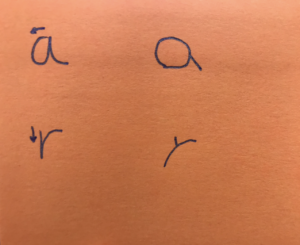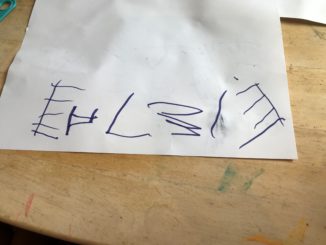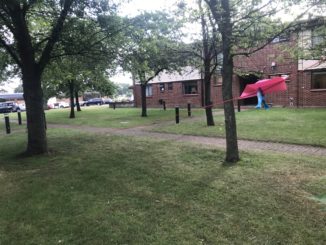People ask me semi-often about learning “letter formation”, or, to put it in other terms, what would be the “right” way to teach children letters? (assuming that they WANT to learn to write letters…none of this information will be nearly as relevant if they are being FORCED to learn to write letters.)
There is technically an order to strokes in letters that makes them the “most efficient” to write. In order to write letters the “most efficient” way possible (i.e., your hand can move the fastest and most fluidly when you are writing very many letters very fast — when you are much older), there might be things like, you make a “bounce” motion or you retrace part of what you’ve already drawn, etc.
Most of the children who I see these days are not taught a motor plan for how to draw letters. They are not taught the order to strokes in the letters. They are given a tracing worksheet or a visual model to copy from. When given a tracing worksheet or a visual model to copy from, you don’t see somebody else move their hand through the process of writing the letter, and you don’t learn the *movement*, you learn the *end result* and try to copy it yourself – which may or may not be a very efficient drawing.
Let me give a couple of examples.
Imagine a lowercase “a” like the one pictured in the visual attached to this post. It’s not the kind of “a” like there is in this font on a computer screen, but the kind that is like a round shape with a line on the right side of it. The “most efficient” way to draw this is by starting at the top right as if drawing a c, then carry on past the end of the c up to the top right again, then bounce downward to create the straight line and end at the bottom right.
I have seen literally too many children to count who draw a lowercase “a” by first drawing an “o” and then putting a stick on it somewhere on the right. (in the image, I have replicated this to the right) It takes 2 separate strokes to do so — they must lift the pencil between the two strokes. It often ends up looking more like a capital Q depending on where they put the line. They are also very likely to start and stop the “o” wherever they feel like, which is very rarely the top right. So imagine you draw an “o” starting at the bottom middle and circling around to conclude at the bottom middle again — it would now be impossible to draw the tail/stick part of it without lifting your pencil and moving to the right. You must draw it in 2 strokes. You must target the “tail” to touch the “o” on the right side of the shape, and line it up accurately, or else you’ll end up with something that looks like “o i” or “o comma” or “o apostrophe” or capital Q. This process of precise targeting with extra strokes slows you down and does not make for efficient, fast, smooth, fluid letter forming.

Here is another example. The “most efficient” way to draw a proper lowercase r is to start at the top left, draw a straight line down to the bottom left, and bounce up and curve over to the right. A shortcut way to draw an r is to bypass it having a “tail”/straight line component at all, which is how it looks in my actual handwriting when I note-take for myself! I just draw a curve from the bottom left to the top right. Most kids have seen a visual model of an r and understand it is supposed to have a tail. They do exactly what I do and draw a curve from the bottom left to top right, but then, because it’s supposed to have a tail and they don’t understand how to make that all part of one stroke (with a “bounce” component), they go back after having made the curve and just stick a stick out of the top curve of the r somewhere. Again…this having to go back, slow down, target the letter, draw a stick on it for no reason, is neither serving the purpose of speeding up their handwriting nor serving the purpose of drawing the shape of the letter correctly.
These are hallmarks of a kid who did not learn how to make a motor plan about how to draw a letter. They learned from copying what they saw visually modelled in a static way — a letter on a page, a letter on a board, a letter on a screen.
Okay, now here’s the other thing: I don’t teach this to kids, like, at all. 98% of the time, there is no point in me teaching this to kids.
That’s because I’m not getting kids at the beginning. It would be impossible for me to get them at the beginning. Someone forced them to begin learning letters when they were 5, 4, 3… It would be almost impossible for me, in my job, to encounter a child with fine motor difficulties early enough to actually teach them this stuff. The earliest I might get to do OT with a kid is if they’re in preschool, but most often it’s in kindergarten, and they can only say that a kid in kindergarten needs OT services if the kid has first been struggling for awhile in kindergarten…and they only struggle with fine motor skills for awhile in kindergarten if they’re being asked to write letters and they can’t. It’s a self-defeating cycle.
Learning the “proper” way to create a motor plan for writing is too much “in the weeds”. It would need to be groundwork laid when they’re first initially interested in learning to write. But it wasn’t, because usually the kids I end up with haven’t ever been through a phase of being interested in learning to write, because it was forced on them when they were 3.
If someone said “I’m interested in learning calligraphy”, you would understand that you have to learn the stroke order, stroke thickness, etc, and that’s just how calligraphy works. If people waited until kids were interested in learning letters and then taught them with an emphasis on the motor plan, it would make their handwriting come smoother and more easily long-term. Obviously they’re still going to make mistakes when they’re a little kid, but if the emphasis is on, “This is the process by which your hand moves around on the page to make this letter,” and not, “This is the end result of what a letter looks like”, it would revolutionize how kids learned! But it HAS to be attached to interest. No kid who’s bored out of their mind that you’re forcing them to learn a letter, also wants to be micromanaged about exactly how to make it come out of their hand.
If I could start from the ground-up with a child, we would do movements with our whole body first, before writing was ever a part of it at all. We would trace out the shape of a big letter with our whole arm, moving at our shoulder and “drawing” in the air, focused on learning the movements of it like one would learn to do a dance. We would draw with big huge movements with chalk outside on the ground or with paint on an easel, moving at the shoulder, moving with a whole arm, moving with a whole body. Then eventually, once the movements of the dance are learned, it can be scaled down and down until it fits on a small paper. This is what I’d do in a perfect world where I knew that I had as much time as it took to wait until the child was interested and then to demonstrate for them in the “I’m sharing an amazing thing with you, that you already love and I happen to know, and I want to share so we can both love it!” type of way, rather than the, “I’m the expert and I know what you need to know, so learn what I’m telling you” type of way. But I don’t live in that world, so I never get to access this side of things. I’m usually too busy doing damage control and trying to connect kids to where they can see writing letters as a delight at all, to worry about how exactly they form those letters.
P.S. This would also help with b/d confusion in many (not all) instances, because the motor plan for a “b” is to start at the top left, draw a straight line down, bounce up and make a curve around to conclude at the bottom left. The motor plan for a “d” is to start at the middle right, draw a “c”, and then continue the tail of the “c” extending upward until it reaches the top right, then bounce down to make a final tail. (or just stop at the top right, if you’re me writing private notes and taking handwriting shortcuts :)) These are very different motor plans, so they emphasise the differences and feel different learning in your body.
P.P.S. This post doesn’t even go into the types of letter formation mistakes that children make when they cannot draw on the diagonal, or cross midline, but are forced to learn writing. They will do their absolute best to adapt to what’s being asked of them when their brain literally doesn’t have the capacity to do what it’s being asked to do yet. A really interesting one is drawing a lowercase “t” by drawing a straight line down, then start at the middle and extend to the left, then go back to the middle and extend to the right. Another really interesting one is start the letter “s” at the middle, then go up and around to make the top half, then return to the middle, then go down and around to make the bottom half. These are soooooo slow and inefficient and also literally the best they can possibly do to cope with unreasonable demands when their brain cannot cross midline or draw a diagonal yet. These are why pre-writing shapes are important!!!



